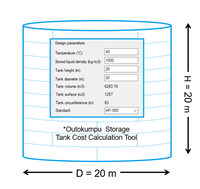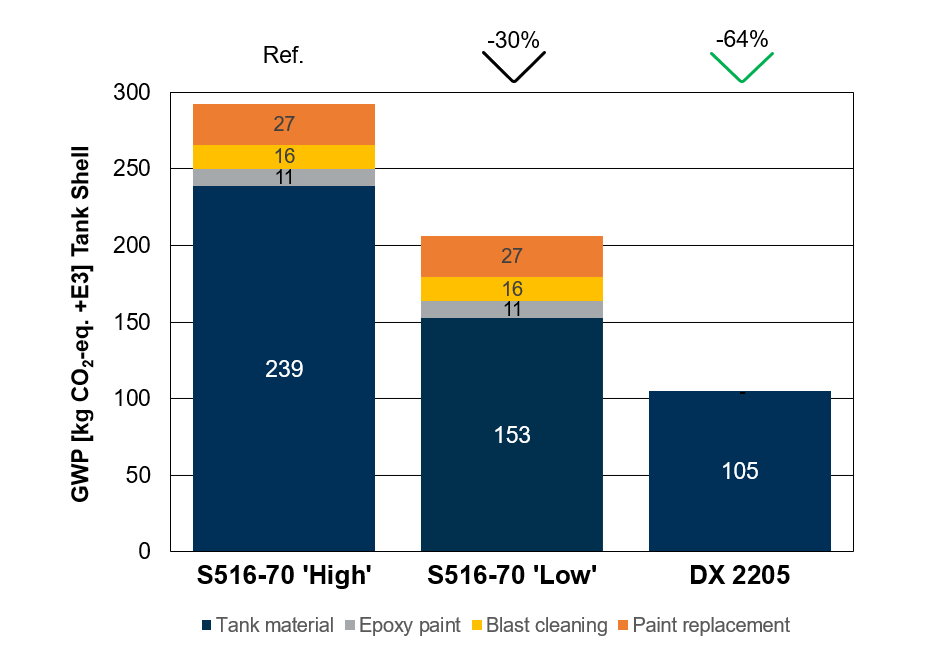Sustainability is a hot topic impacting the process industry. Thus, the carbon dioxide (CO
2) footprint is becoming an increasingly important factor to consider. When talking about the CO
2 impact of steel products, it is of utmost importance to consider the full picture of the total CO
2 footprint, i.e., scope 1 (direct emissions from own production), scope 2 (emissions from electricity use) and scope 3 (all indirect emissions from supply chain including raw materials).
There are big regional differences when it comes to the sourcing of energy, electricity and virgin alloying elements. In addition, the amount of scrap utilized as raw material strongly influences the footprint of a stainless steel plant. Outokumpu has advantages with its own ferrochrome mine, high recycled content of over 90%, and the use of low carbon electricity, which are the key factors of having a CO
2 footprint that is 70% lower than the global industry average. Climate compensation is not used in the calculation of Outokumpu’s emissions.
Stainless Steel versus Carbon SteelIn stainless steel production, electric arc furnaces (EAF) have been used for decades — a technology that the carbon steel industry only partly started to use. An EAF process is much less energy-intensive and uses scrap instead of virgin iron ore for melting. This has a positive impact on the emissions level of the melt shop. Especially for high alloyed stainless steels, the use of scrap is of high importance as virgin alloying elements such as chromium and nickel have very high impact.
In general, stainless steel is sustainable, durable, and designed to last forever. Selecting the right grade, no coating process is required, which saves process time, costs, and CO
2. Moreover, without any coating, the material does not require any pretreatment to get 100% recycled.
Finally, you can gain further profit from high strength stainless steel. High strength materials enable lightweight designs, which means less material and therewith CO
2 emission savings.
Carbon Footprint on a Grade LevelTo calculate the complete CO
2 emissions (scope 1-3) across the supply chain, it is essential to know the CO
2 impact of the pre-material. Therefore, the product carbon footprint (PCF) is important. Outokumpu developed a tool that calculates a grade-specific PCF (scope 1-3, cradle-to-gate), which can then be printed on material certificate issued by the mills. The process for calculating is based on ISO 14067 standard and third-party verification.
When it comes to Forta DX 2205 (EN 1.4462, UNS S32205), Outokumpu’s PCF is 1.8 kg CO
2– equivalent per 1 kg steel (twelve-month-rolling average to September 2022). The current cradle-to-gate emission level declared for carbon steel is on par or higher in the range 1.73 - 2.71 kg CO
2– eq. per 1 kg steel depending on identified suppliers’ specific production process*. Note, the emission data for carbon steel is not grade specific, it is based on a typical composition.
Life Cycle Assessment of Duplex Stainless Steel in Storage TankLife Cycle Assessment (LCA) is a systematic process to quantify the total CO
2 emissions generated by a product or application

over its life
cycle, from extraction of resources, through production, use, disposal, and if applicable, recycling. ISO 14040, 14044 and 21930 provide a framework for how to perform an LCA study. These standards were originally developed by the buildings and civil engineering sector but can equally be applied to other industry sectors such as chemical process industry and its typical applications, e.g., storage tanks and process vessels.
To give an example, the CO
2 footprint of a 20 m tall and 20 m wide cylindrical tank shell is shown in Figure 1 comparing a carbon steel A516-70 with Duplex 2205 (S32205). For the carbon steel, a 2 mm corrosion allowance and coating application (blast cleaning and epoxy paint) of both inside and outside are considered in the study*. The material consumption is reduced by 30% using the higher strength duplex grade in accordance with API 650. A complete coating replacement of the carbon steel shell is expected once over the life cycle.
The CO2 emissions for carbon steel (e.g., A516-70) are in a range as presented in the previous section, where the upper and lower bounds are used here, denoted as ‘high’ and ‘low’ in Figure 2.”

(The lower bound reflects the benefit of using more scrap based than conventional iron ore based steelmaking.) The LCA results depicted in Figure 2, cradle-to-grave (excluding end-of-life impacts), indicate a potential reduction of up to 64% using Duplex 2205. Note, this is a simplified analysis but gives a hint that the duplex tank offers greater potential to reduce the total CO
2 footprint in a Life Cycle Assessment study compared to a coated carbon steel tank.
* Emission data for the carbon steel is taken from EPDs provided by SSAB, ArcelorMittal, Hyundai Steel and AISC. Emission data for water based epoxy paint refers to EPD published by Jotun A/S.
By Claes Tigerstrand, Outokumpu
This article was originally published in MTI CONNECT 2022, Issue 3.